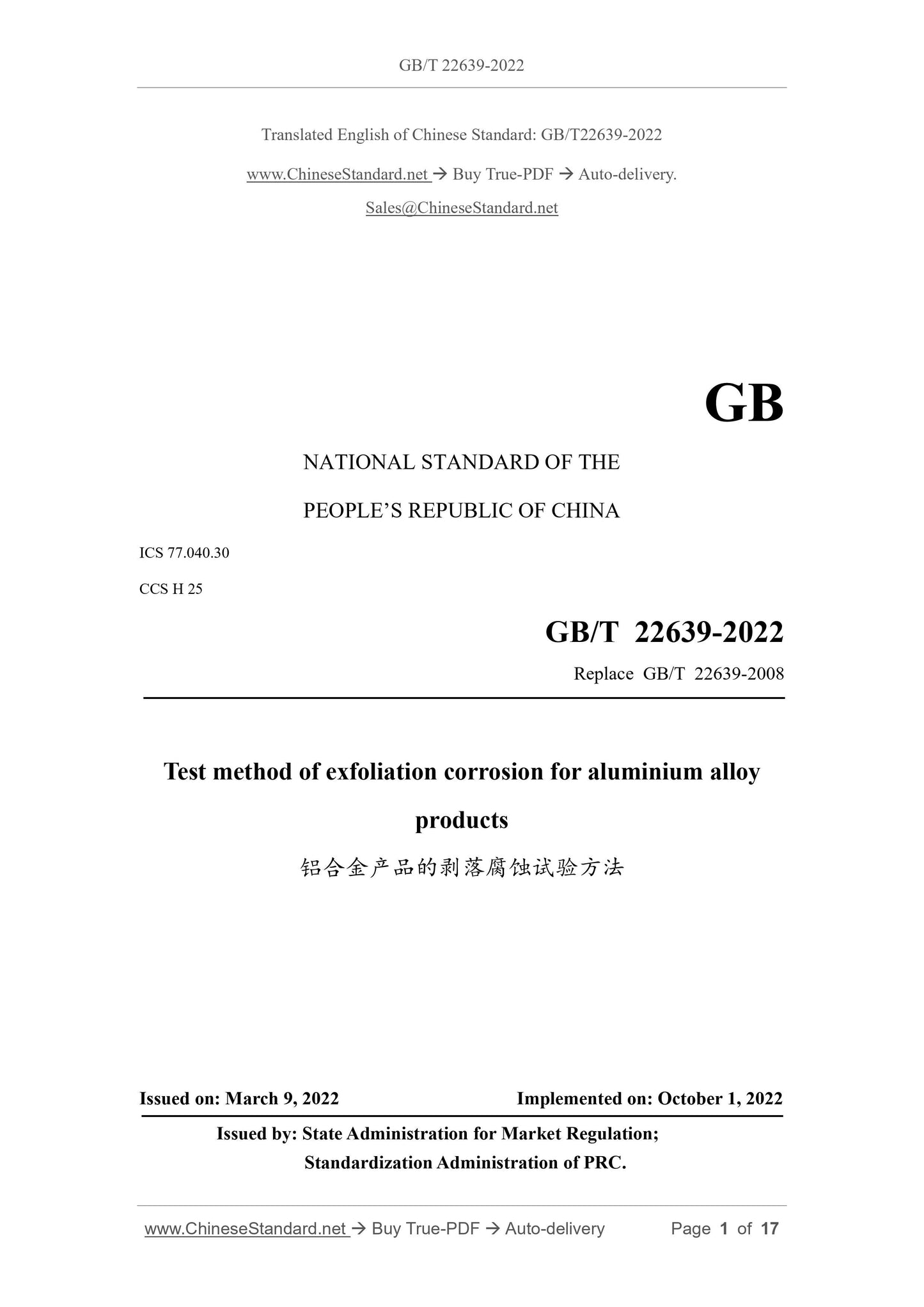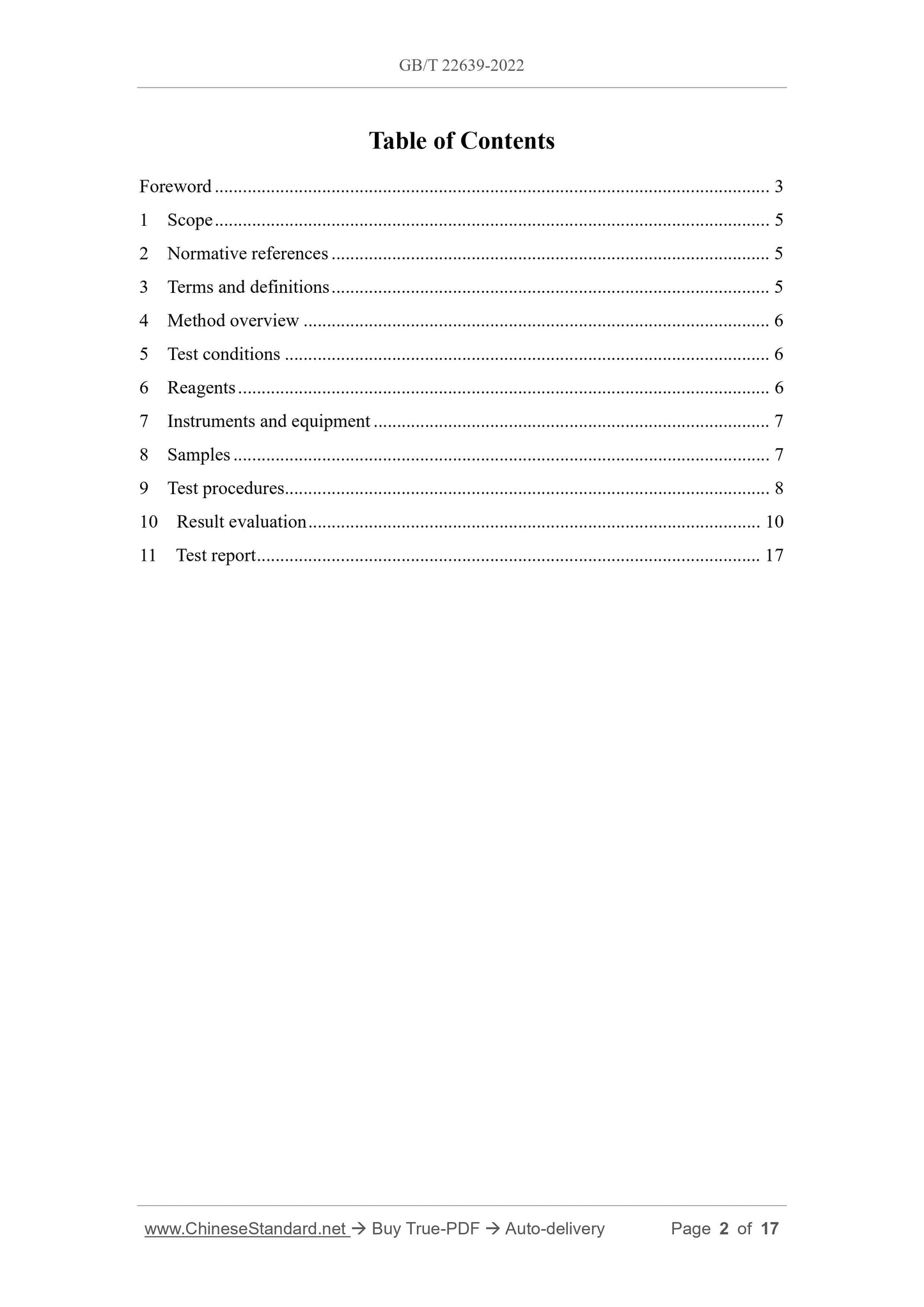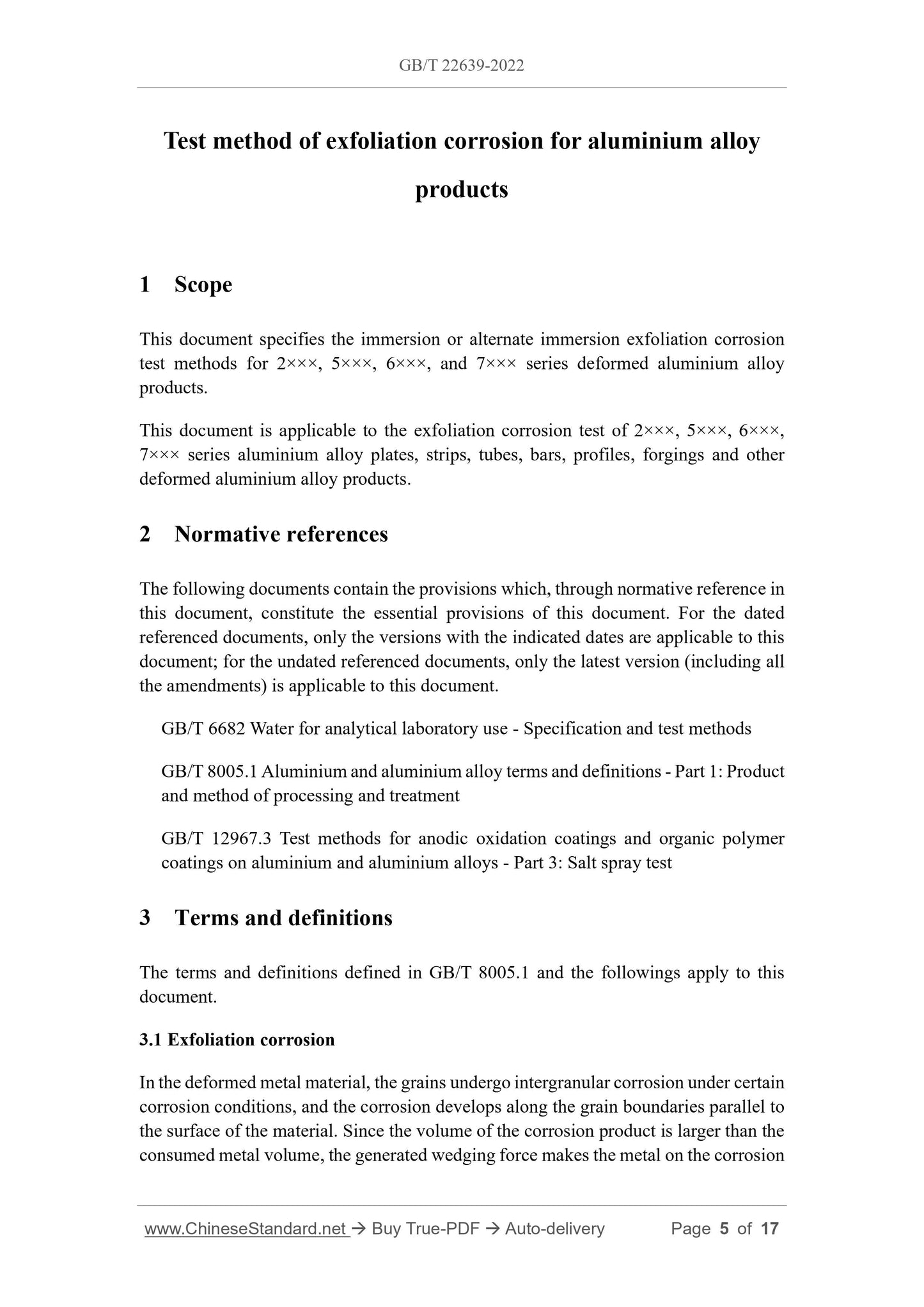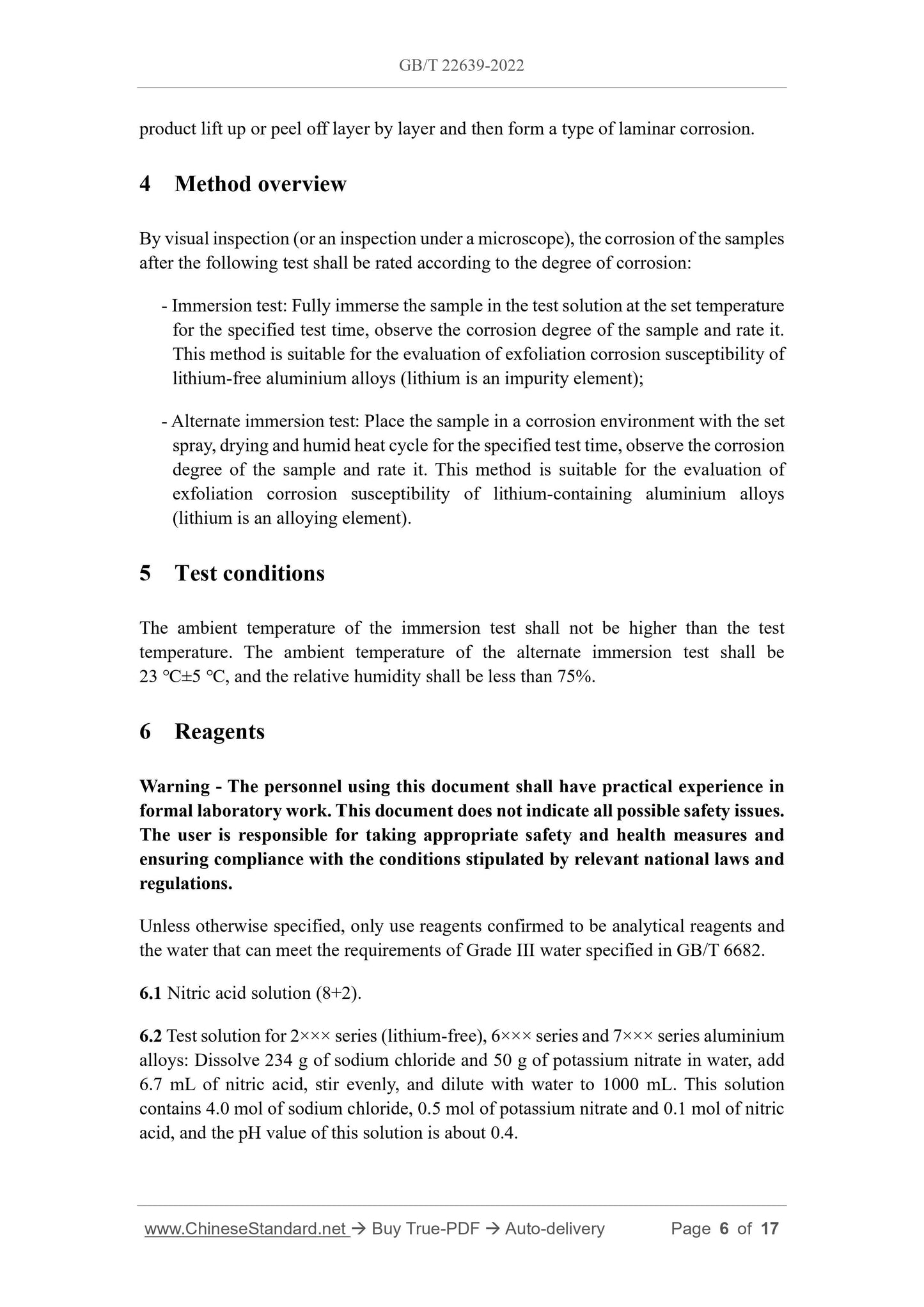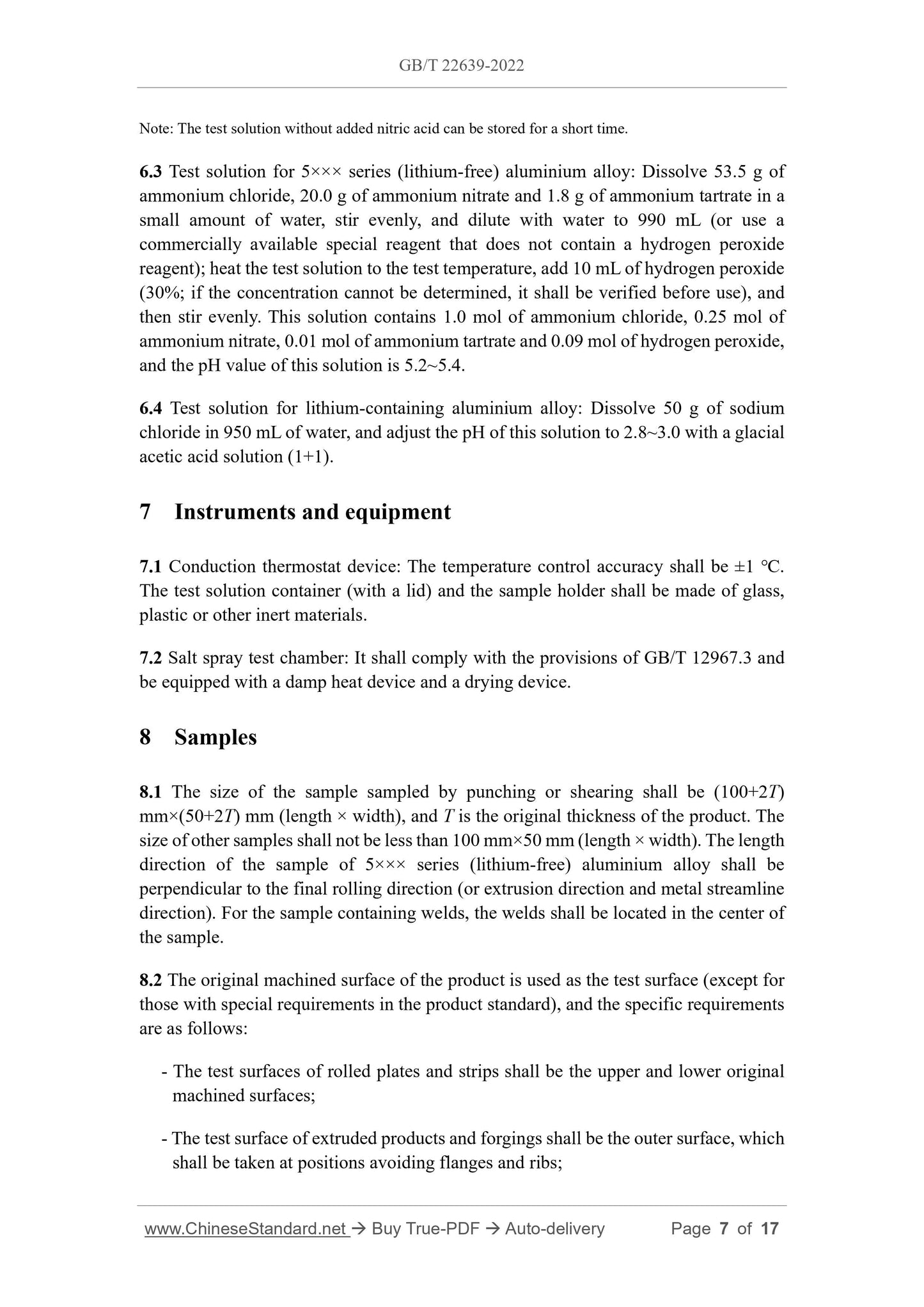1
/
of
5
www.ChineseStandard.us -- Field Test Asia Pte. Ltd.
GB/T 22639-2022 English PDF (GB/T22639-2022)
GB/T 22639-2022 English PDF (GB/T22639-2022)
Regular price
$215.00
Regular price
Sale price
$215.00
Unit price
/
per
Shipping calculated at checkout.
Couldn't load pickup availability
GB/T 22639-2022: Test method of exfoliation corrosion for aluminium alloy products
Delivery: 9 seconds. Download (& Email) true-PDF + Invoice.
Get Quotation: Click GB/T 22639-2022 (Self-service in 1-minute)
Historical versions (Master-website): GB/T 22639-2022
Preview True-PDF (Reload/Scroll-down if blank)
GB/T 22639-2022
NATIONAL STANDARD OF THE
PEOPLE’S REPUBLIC OF CHINA
ICS 77.040.30
CCS H 25
Replace GB/T 22639-2008
Test method of exfoliation corrosion for aluminium alloy
products
ISSUED ON: MARCH 9, 2022
IMPLEMENTED ON: OCTOBER 1, 2022
Issued by: State Administration for Market Regulation;
Standardization Administration of PRC.
Table of Contents
Foreword ... 3
1 Scope ... 5
2 Normative references ... 5
3 Terms and definitions ... 5
4 Method overview ... 6
5 Test conditions ... 6
6 Reagents ... 6
7 Instruments and equipment ... 7
8 Samples ... 7
9 Test procedures ... 8
10 Result evaluation ... 10
11 Test report ... 17
Test method of exfoliation corrosion for aluminium alloy
products
1 Scope
This document specifies the immersion or alternate immersion exfoliation corrosion
test methods for 2×××, 5×××, 6×××, and 7××× series deformed aluminium alloy
products.
This document is applicable to the exfoliation corrosion test of 2×××, 5×××, 6×××,
7××× series aluminium alloy plates, strips, tubes, bars, profiles, forgings and other
deformed aluminium alloy products.
2 Normative references
The following documents contain the provisions which, through normative reference in
this document, constitute the essential provisions of this document. For the dated
referenced documents, only the versions with the indicated dates are applicable to this
document; for the undated referenced documents, only the latest version (including all
the amendments) is applicable to this document.
GB/T 6682 Water for analytical laboratory use - Specification and test methods
GB/T 8005.1 Aluminium and aluminium alloy terms and definitions - Part 1: Product
and method of processing and treatment
GB/T 12967.3 Test methods for anodic oxidation coatings and organic polymer
coatings on aluminium and aluminium alloys - Part 3: Salt spray test
3 Terms and definitions
The terms and definitions defined in GB/T 8005.1 and the followings apply to this
document.
3.1 Exfoliation corrosion
In the deformed metal material, the grains undergo intergranular corrosion under certain
corrosion conditions, and the corrosion develops along the grain boundaries parallel to
the surface of the material. Since the volume of the corrosion product is larger than the
consumed metal volume, the generated wedging force makes the metal on the corrosion
product lift up or peel off layer by layer and then form a type of laminar corrosion.
4 Method overview
By visual inspection (or an inspection under a microscope), the corrosion of the samples
after the following test shall be rated according to the degree of corrosion:
- Immersion test: Fully immerse the sample in the test solution at the set temperature
for the specified test time, observe the corrosion degree of the sample and rate it.
This method is suitable for the evaluation of exfoliation corrosion susceptibility of
lithium-free aluminium alloys (lithium is an impurity element);
- Alternate immersion test: Place the sample in a corrosion environment with the set
spray, drying and humid heat cycle for the specified test time, observe the corrosion
degree of the sample and rate it. This method is suitable for the evaluation of
exfoliation corrosion susceptibility of lithium-containing aluminium alloys
(lithium is an alloying element).
5 Test conditions
The ambient temperature of the immersion test shall not be higher than the test
temperature. The ambient temperature of the alternate immersion test shall be
23 ℃±5 ℃, and the relative humidity shall be less than 75%.
6 Reagents
Warning - The personnel using this document shall have practical experience in
formal laboratory work. This document does not indicate all possible safety issues.
The user is responsible for taking appropriate safety and health measures and
ensuring compliance with the conditions stipulated by relevant national laws and
regulations.
Unless otherwise specified, only use reagents confirmed to be analytical reagents and
the water that can meet the requirements of Grade III water specified in GB/T 6682.
6.1 Nitric acid solution (8+2).
6.2 Test solution for 2××× series (lithium-free), 6××× series and 7××× series aluminium
alloys: Dissolve 234 g of sodium chloride and 50 g of potassium nitrate in water, add
6.7 mL of nitric acid, stir evenly, and dilute with water to 1000 mL. This solution
contains 4.0 mol of sodium chloride, 0.5 mol of potassium nitrate and 0.1 mol of nitric
acid, and the pH value of this solution is about 0.4.
Note: The test solution without added nitric acid can be stored for a short time.
6.3 Test solution for 5××× series (lithium-free) aluminium alloy: Dissolve 53.5 g of
ammonium chloride, 20.0 g of ammonium nitrate and 1.8 g of ammonium tartrate in a
small amount of water, stir evenly, and dilute with water to 990 mL (or use a
commercially available special reagent that does not contain a hydrogen peroxide
reagent); heat the test solution to the test temperature, add 10 mL of hydrogen peroxide
(30%; if the concentration cannot be determined, it shall be verified before use), and
then stir evenly. This solution contains 1.0 mol of ammonium chloride, 0.25 mol of
ammonium nitrate, 0.01 mol of ammonium tartrate and 0.09 mol of hydrogen peroxide,
and the pH value of this solution is 5.2~5.4.
6.4 Test solution for lithium-containing aluminium alloy: Dissolve 50 g of sodium
chloride in 950 mL of water, and adjust the pH of this solution to 2.8~3.0 with a glacial
acetic acid solution (1+1).
7 Instruments and equipment
7.1 Conduction thermostat device: The temperature control accuracy shall be ±1 ℃.
The test solution container (with a lid) and the sample holder shall be made of glass,
plastic or other inert materials.
7.2 Salt spray test chamber: It shall comply with the provisions of GB/T 12967.3 and
be equipped with a damp heat device and a drying device.
8 Samples
8.1 The size of the sample sampled by punching or shearing shall be (100+2T)
mm×(50+2T) mm (length × width), and T is the original thickness of the product. The
size of other samples shall not be less than 100 mm×50 mm (length × width). The length
direction of the sample of 5××× series (lithium-free) aluminium alloy shall be
perpendicular to the final rolling direction (or extrusion direction and metal streamline
direction). For the sample containing welds, the welds shall be located in the center of
the sample.
8.2 The original machined surface of the product is used as the test surface (except for
those with special requirements in the product standard), and the specific requirements
are as follows:
- The test surfaces of rolled plates and strips shall be the upper and lower original
machined surfaces;
- The test surface of extruded products and forgings shall be the outer surface, which
shall be taken at positions avoiding flanges and ribs;
GB/T 22639-2022
NATIONAL STANDARD OF THE
PEOPLE’S REPUBLIC OF CHINA
ICS 77.040.30
CCS H 25
Replace GB/T 22639-2008
Test method of exfoliation corrosion for aluminium alloy
products
ISSUED ON: MARCH 9, 2022
IMPLEMENTED ON: OCTOBER 1, 2022
Issued by: State Administration for Market Regulation;
Standardization Administration of PRC.
Table of Contents
Foreword ... 3
1 Scope ... 5
2 Normative references ... 5
3 Terms and definitions ... 5
4 Method overview ... 6
5 Test conditions ... 6
6 Reagents ... 6
7 Instruments and equipment ... 7
8 Samples ... 7
9 Test procedures ... 8
10 Result evaluation ... 10
11 Test report ... 17
Test method of exfoliation corrosion for aluminium alloy
products
1 Scope
This document specifies the immersion or alternate immersion exfoliation corrosion
test methods for 2×××, 5×××, 6×××, and 7××× series deformed aluminium alloy
products.
This document is applicable to the exfoliation corrosion test of 2×××, 5×××, 6×××,
7××× series aluminium alloy plates, strips, tubes, bars, profiles, forgings and other
deformed aluminium alloy products.
2 Normative references
The following documents contain the provisions which, through normative reference in
this document, constitute the essential provisions of this document. For the dated
referenced documents, only the versions with the indicated dates are applicable to this
document; for the undated referenced documents, only the latest version (including all
the amendments) is applicable to this document.
GB/T 6682 Water for analytical laboratory use - Specification and test methods
GB/T 8005.1 Aluminium and aluminium alloy terms and definitions - Part 1: Product
and method of processing and treatment
GB/T 12967.3 Test methods for anodic oxidation coatings and organic polymer
coatings on aluminium and aluminium alloys - Part 3: Salt spray test
3 Terms and definitions
The terms and definitions defined in GB/T 8005.1 and the followings apply to this
document.
3.1 Exfoliation corrosion
In the deformed metal material, the grains undergo intergranular corrosion under certain
corrosion conditions, and the corrosion develops along the grain boundaries parallel to
the surface of the material. Since the volume of the corrosion product is larger than the
consumed metal volume, the generated wedging force makes the metal on the corrosion
product lift up or peel off layer by layer and then form a type of laminar corrosion.
4 Method overview
By visual inspection (or an inspection under a microscope), the corrosion of the samples
after the following test shall be rated according to the degree of corrosion:
- Immersion test: Fully immerse the sample in the test solution at the set temperature
for the specified test time, observe the corrosion degree of the sample and rate it.
This method is suitable for the evaluation of exfoliation corrosion susceptibility of
lithium-free aluminium alloys (lithium is an impurity element);
- Alternate immersion test: Place the sample in a corrosion environment with the set
spray, drying and humid heat cycle for the specified test time, observe the corrosion
degree of the sample and rate it. This method is suitable for the evaluation of
exfoliation corrosion susceptibility of lithium-containing aluminium alloys
(lithium is an alloying element).
5 Test conditions
The ambient temperature of the immersion test shall not be higher than the test
temperature. The ambient temperature of the alternate immersion test shall be
23 ℃±5 ℃, and the relative humidity shall be less than 75%.
6 Reagents
Warning - The personnel using this document shall have practical experience in
formal laboratory work. This document does not indicate all possible safety issues.
The user is responsible for taking appropriate safety and health measures and
ensuring compliance with the conditions stipulated by relevant national laws and
regulations.
Unless otherwise specified, only use reagents confirmed to be analytical reagents and
the water that can meet the requirements of Grade III water specified in GB/T 6682.
6.1 Nitric acid solution (8+2).
6.2 Test solution for 2××× series (lithium-free), 6××× series and 7××× series aluminium
alloys: Dissolve 234 g of sodium chloride and 50 g of potassium nitrate in water, add
6.7 mL of nitric acid, stir evenly, and dilute with water to 1000 mL. This solution
contains 4.0 mol of sodium chloride, 0.5 mol of potassium nitrate and 0.1 mol of nitric
acid, and the pH value of this solution is about 0.4.
Note: The test solution without added nitric acid can be stored for a short time.
6.3 Test solution for 5××× series (lithium-free) aluminium alloy: Dissolve 53.5 g of
ammonium chloride, 20.0 g of ammonium nitrate and 1.8 g of ammonium tartrate in a
small amount of water, stir evenly, and dilute with water to 990 mL (or use a
commercially available special reagent that does not contain a hydrogen peroxide
reagent); heat the test solution to the test temperature, add 10 mL of hydrogen peroxide
(30%; if the concentration cannot be determined, it shall be verified before use), and
then stir evenly. This solution contains 1.0 mol of ammonium chloride, 0.25 mol of
ammonium nitrate, 0.01 mol of ammonium tartrate and 0.09 mol of hydrogen peroxide,
and the pH value of this solution is 5.2~5.4.
6.4 Test solution for lithium-containing aluminium alloy: Dissolve 50 g of sodium
chloride in 950 mL of water, and adjust the pH of this solution to 2.8~3.0 with a glacial
acetic acid solution (1+1).
7 Instruments and equipment
7.1 Conduction thermostat device: The temperature control accuracy shall be ±1 ℃.
The test solution container (with a lid) and the sample holder shall be made of glass,
plastic or other inert materials.
7.2 Salt spray test chamber: It shall comply with the provisions of GB/T 12967.3 and
be equipped with a damp heat device and a drying device.
8 Samples
8.1 The size of the sample sampled by punching or shearing shall be (100+2T)
mm×(50+2T) mm (length × width), and T is the original thickness of the product. The
size of other samples shall not be less than 100 mm×50 mm (length × width). The length
direction of the sample of 5××× series (lithium-free) aluminium alloy shall be
perpendicular to the final rolling direction (or extrusion direction and metal streamline
direction). For the sample containing welds, the welds shall be located in the center of
the sample.
8.2 The original machined surface of the product is used as the test surface (except for
those with special requirements in the product standard), and the specific requirements
are as follows:
- The test surfaces of rolled plates and strips shall be the upper and lower original
machined surfaces;
- The test surface of extruded products and forgings shall be the outer surface, which
shall be taken at positions avoiding flanges and ribs;
Delivery: 9 seconds. Download (& Email) true-PDF + Invoice.
Get Quotation: Click GB/T 22639-2022 (Self-service in 1-minute)
Historical versions (Master-website): GB/T 22639-2022
Preview True-PDF (Reload/Scroll-down if blank)
GB/T 22639-2022
NATIONAL STANDARD OF THE
PEOPLE’S REPUBLIC OF CHINA
ICS 77.040.30
CCS H 25
Replace GB/T 22639-2008
Test method of exfoliation corrosion for aluminium alloy
products
ISSUED ON: MARCH 9, 2022
IMPLEMENTED ON: OCTOBER 1, 2022
Issued by: State Administration for Market Regulation;
Standardization Administration of PRC.
Table of Contents
Foreword ... 3
1 Scope ... 5
2 Normative references ... 5
3 Terms and definitions ... 5
4 Method overview ... 6
5 Test conditions ... 6
6 Reagents ... 6
7 Instruments and equipment ... 7
8 Samples ... 7
9 Test procedures ... 8
10 Result evaluation ... 10
11 Test report ... 17
Test method of exfoliation corrosion for aluminium alloy
products
1 Scope
This document specifies the immersion or alternate immersion exfoliation corrosion
test methods for 2×××, 5×××, 6×××, and 7××× series deformed aluminium alloy
products.
This document is applicable to the exfoliation corrosion test of 2×××, 5×××, 6×××,
7××× series aluminium alloy plates, strips, tubes, bars, profiles, forgings and other
deformed aluminium alloy products.
2 Normative references
The following documents contain the provisions which, through normative reference in
this document, constitute the essential provisions of this document. For the dated
referenced documents, only the versions with the indicated dates are applicable to this
document; for the undated referenced documents, only the latest version (including all
the amendments) is applicable to this document.
GB/T 6682 Water for analytical laboratory use - Specification and test methods
GB/T 8005.1 Aluminium and aluminium alloy terms and definitions - Part 1: Product
and method of processing and treatment
GB/T 12967.3 Test methods for anodic oxidation coatings and organic polymer
coatings on aluminium and aluminium alloys - Part 3: Salt spray test
3 Terms and definitions
The terms and definitions defined in GB/T 8005.1 and the followings apply to this
document.
3.1 Exfoliation corrosion
In the deformed metal material, the grains undergo intergranular corrosion under certain
corrosion conditions, and the corrosion develops along the grain boundaries parallel to
the surface of the material. Since the volume of the corrosion product is larger than the
consumed metal volume, the generated wedging force makes the metal on the corrosion
product lift up or peel off layer by layer and then form a type of laminar corrosion.
4 Method overview
By visual inspection (or an inspection under a microscope), the corrosion of the samples
after the following test shall be rated according to the degree of corrosion:
- Immersion test: Fully immerse the sample in the test solution at the set temperature
for the specified test time, observe the corrosion degree of the sample and rate it.
This method is suitable for the evaluation of exfoliation corrosion susceptibility of
lithium-free aluminium alloys (lithium is an impurity element);
- Alternate immersion test: Place the sample in a corrosion environment with the set
spray, drying and humid heat cycle for the specified test time, observe the corrosion
degree of the sample and rate it. This method is suitable for the evaluation of
exfoliation corrosion susceptibility of lithium-containing aluminium alloys
(lithium is an alloying element).
5 Test conditions
The ambient temperature of the immersion test shall not be higher than the test
temperature. The ambient temperature of the alternate immersion test shall be
23 ℃±5 ℃, and the relative humidity shall be less than 75%.
6 Reagents
Warning - The personnel using this document shall have practical experience in
formal laboratory work. This document does not indicate all possible safety issues.
The user is responsible for taking appropriate safety and health measures and
ensuring compliance with the conditions stipulated by relevant national laws and
regulations.
Unless otherwise specified, only use reagents confirmed to be analytical reagents and
the water that can meet the requirements of Grade III water specified in GB/T 6682.
6.1 Nitric acid solution (8+2).
6.2 Test solution for 2××× series (lithium-free), 6××× series and 7××× series aluminium
alloys: Dissolve 234 g of sodium chloride and 50 g of potassium nitrate in water, add
6.7 mL of nitric acid, stir evenly, and dilute with water to 1000 mL. This solution
contains 4.0 mol of sodium chloride, 0.5 mol of potassium nitrate and 0.1 mol of nitric
acid, and the pH value of this solution is about 0.4.
Note: The test solution without added nitric acid can be stored for a short time.
6.3 Test solution for 5××× series (lithium-free) aluminium alloy: Dissolve 53.5 g of
ammonium chloride, 20.0 g of ammonium nitrate and 1.8 g of ammonium tartrate in a
small amount of water, stir evenly, and dilute with water to 990 mL (or use a
commercially available special reagent that does not contain a hydrogen peroxide
reagent); heat the test solution to the test temperature, add 10 mL of hydrogen peroxide
(30%; if the concentration cannot be determined, it shall be verified before use), and
then stir evenly. This solution contains 1.0 mol of ammonium chloride, 0.25 mol of
ammonium nitrate, 0.01 mol of ammonium tartrate and 0.09 mol of hydrogen peroxide,
and the pH value of this solution is 5.2~5.4.
6.4 Test solution for lithium-containing aluminium alloy: Dissolve 50 g of sodium
chloride in 950 mL of water, and adjust the pH of this solution to 2.8~3.0 with a glacial
acetic acid solution (1+1).
7 Instruments and equipment
7.1 Conduction thermostat device: The temperature control accuracy shall be ±1 ℃.
The test solution container (with a lid) and the sample holder shall be made of glass,
plastic or other inert materials.
7.2 Salt spray test chamber: It shall comply with the provisions of GB/T 12967.3 and
be equipped with a damp heat device and a drying device.
8 Samples
8.1 The size of the sample sampled by punching or shearing shall be (100+2T)
mm×(50+2T) mm (length × width), and T is the original thickness of the product. The
size of other samples shall not be less than 100 mm×50 mm (length × width). The length
direction of the sample of 5××× series (lithium-free) aluminium alloy shall be
perpendicular to the final rolling direction (or extrusion direction and metal streamline
direction). For the sample containing welds, the welds shall be located in the center of
the sample.
8.2 The original machined surface of the product is used as the test surface (except for
those with special requirements in the product standard), and the specific requirements
are as follows:
- The test surfaces of rolled plates and strips shall be the upper and lower original
machined surfaces;
- The test surface of extruded products and forgings shall be the outer surface, which
shall be taken at positions avoiding flanges and ribs;
GB/T 22639-2022
NATIONAL STANDARD OF THE
PEOPLE’S REPUBLIC OF CHINA
ICS 77.040.30
CCS H 25
Replace GB/T 22639-2008
Test method of exfoliation corrosion for aluminium alloy
products
ISSUED ON: MARCH 9, 2022
IMPLEMENTED ON: OCTOBER 1, 2022
Issued by: State Administration for Market Regulation;
Standardization Administration of PRC.
Table of Contents
Foreword ... 3
1 Scope ... 5
2 Normative references ... 5
3 Terms and definitions ... 5
4 Method overview ... 6
5 Test conditions ... 6
6 Reagents ... 6
7 Instruments and equipment ... 7
8 Samples ... 7
9 Test procedures ... 8
10 Result evaluation ... 10
11 Test report ... 17
Test method of exfoliation corrosion for aluminium alloy
products
1 Scope
This document specifies the immersion or alternate immersion exfoliation corrosion
test methods for 2×××, 5×××, 6×××, and 7××× series deformed aluminium alloy
products.
This document is applicable to the exfoliation corrosion test of 2×××, 5×××, 6×××,
7××× series aluminium alloy plates, strips, tubes, bars, profiles, forgings and other
deformed aluminium alloy products.
2 Normative references
The following documents contain the provisions which, through normative reference in
this document, constitute the essential provisions of this document. For the dated
referenced documents, only the versions with the indicated dates are applicable to this
document; for the undated referenced documents, only the latest version (including all
the amendments) is applicable to this document.
GB/T 6682 Water for analytical laboratory use - Specification and test methods
GB/T 8005.1 Aluminium and aluminium alloy terms and definitions - Part 1: Product
and method of processing and treatment
GB/T 12967.3 Test methods for anodic oxidation coatings and organic polymer
coatings on aluminium and aluminium alloys - Part 3: Salt spray test
3 Terms and definitions
The terms and definitions defined in GB/T 8005.1 and the followings apply to this
document.
3.1 Exfoliation corrosion
In the deformed metal material, the grains undergo intergranular corrosion under certain
corrosion conditions, and the corrosion develops along the grain boundaries parallel to
the surface of the material. Since the volume of the corrosion product is larger than the
consumed metal volume, the generated wedging force makes the metal on the corrosion
product lift up or peel off layer by layer and then form a type of laminar corrosion.
4 Method overview
By visual inspection (or an inspection under a microscope), the corrosion of the samples
after the following test shall be rated according to the degree of corrosion:
- Immersion test: Fully immerse the sample in the test solution at the set temperature
for the specified test time, observe the corrosion degree of the sample and rate it.
This method is suitable for the evaluation of exfoliation corrosion susceptibility of
lithium-free aluminium alloys (lithium is an impurity element);
- Alternate immersion test: Place the sample in a corrosion environment with the set
spray, drying and humid heat cycle for the specified test time, observe the corrosion
degree of the sample and rate it. This method is suitable for the evaluation of
exfoliation corrosion susceptibility of lithium-containing aluminium alloys
(lithium is an alloying element).
5 Test conditions
The ambient temperature of the immersion test shall not be higher than the test
temperature. The ambient temperature of the alternate immersion test shall be
23 ℃±5 ℃, and the relative humidity shall be less than 75%.
6 Reagents
Warning - The personnel using this document shall have practical experience in
formal laboratory work. This document does not indicate all possible safety issues.
The user is responsible for taking appropriate safety and health measures and
ensuring compliance with the conditions stipulated by relevant national laws and
regulations.
Unless otherwise specified, only use reagents confirmed to be analytical reagents and
the water that can meet the requirements of Grade III water specified in GB/T 6682.
6.1 Nitric acid solution (8+2).
6.2 Test solution for 2××× series (lithium-free), 6××× series and 7××× series aluminium
alloys: Dissolve 234 g of sodium chloride and 50 g of potassium nitrate in water, add
6.7 mL of nitric acid, stir evenly, and dilute with water to 1000 mL. This solution
contains 4.0 mol of sodium chloride, 0.5 mol of potassium nitrate and 0.1 mol of nitric
acid, and the pH value of this solution is about 0.4.
Note: The test solution without added nitric acid can be stored for a short time.
6.3 Test solution for 5××× series (lithium-free) aluminium alloy: Dissolve 53.5 g of
ammonium chloride, 20.0 g of ammonium nitrate and 1.8 g of ammonium tartrate in a
small amount of water, stir evenly, and dilute with water to 990 mL (or use a
commercially available special reagent that does not contain a hydrogen peroxide
reagent); heat the test solution to the test temperature, add 10 mL of hydrogen peroxide
(30%; if the concentration cannot be determined, it shall be verified before use), and
then stir evenly. This solution contains 1.0 mol of ammonium chloride, 0.25 mol of
ammonium nitrate, 0.01 mol of ammonium tartrate and 0.09 mol of hydrogen peroxide,
and the pH value of this solution is 5.2~5.4.
6.4 Test solution for lithium-containing aluminium alloy: Dissolve 50 g of sodium
chloride in 950 mL of water, and adjust the pH of this solution to 2.8~3.0 with a glacial
acetic acid solution (1+1).
7 Instruments and equipment
7.1 Conduction thermostat device: The temperature control accuracy shall be ±1 ℃.
The test solution container (with a lid) and the sample holder shall be made of glass,
plastic or other inert materials.
7.2 Salt spray test chamber: It shall comply with the provisions of GB/T 12967.3 and
be equipped with a damp heat device and a drying device.
8 Samples
8.1 The size of the sample sampled by punching or shearing shall be (100+2T)
mm×(50+2T) mm (length × width), and T is the original thickness of the product. The
size of other samples shall not be less than 100 mm×50 mm (length × width). The length
direction of the sample of 5××× series (lithium-free) aluminium alloy shall be
perpendicular to the final rolling direction (or extrusion direction and metal streamline
direction). For the sample containing welds, the welds shall be located in the center of
the sample.
8.2 The original machined surface of the product is used as the test surface (except for
those with special requirements in the product standard), and the specific requirements
are as follows:
- The test surfaces of rolled plates and strips shall be the upper and lower original
machined surfaces;
- The test surface of extruded products and forgings shall be the outer surface, which
shall be taken at positions avoiding flanges and ribs;
Share
